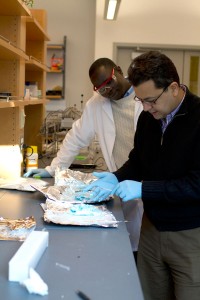Fiber scientists at Cornell University have discovered ways to manipulate cotton into high-tech, electronic devices that will help improve many aspects of life — including military, athletic, medical and personal.

Juan Hinestroza, professor of fiber science and head of the cotton development research team at Cornell, said the research paves the way for “smart clothing,” with abilities ranging from temperature control to protection from harmful chemicals.
“We can make cotton to conduct electricity,” he said. “We can make cotton to kill bacteria, we can make cotton to repel water, we can even make cotton to change colors — basically, we try to teach new tricks to an old fiber.”
Frederick Ochanda, postdoctoral associate and member of the cotton development team at Cornell, said the secret lies in nanoscale science, which involves controlling the molecules on the surface of the cotton with precise chemistry. Scientists embed nanoparticles of metals, such as gold, platinum, ruthenium, copper, silver and metal organic frameworks, or MOFs, into the cotton.
“Fabrics with embedded nanoparticles, or MOFs, can be developed into technology that can selectively capture gases,” Ochanda said.
This technology may sound like it comes from a futuristic novel, but the Cornell scientists said they believe it will be integrated into daily life within this decade. With proper investment, it can be transferred to existing manufacturers and be made in less than seven years, Hinestroza said.
Military personnel, first responders and others at high risk for exposure to toxic chemicals will benefit from the ability of scientists to apply this capability to cotton clothing, Ochanda said. Cotton gloves, footwear and duty uniforms can be infused with gas-capturing metals to create built-in filtration systems to protect people from chemicals they may face while on the job.
“Some of the work that we do is actually sponsored by the Department of Defense, so we are interested in decomposing chemical warfare agents and protecting people who are exposed to them,” Hinestroza said. “We also want to protect them against biological agents, like viruses or bacteria.”
Hinestroza said this technology can also be applied in other fields. In athletics, it can be used to monitor the body temperature, heart rate and performance level of professional athletes. In hospitals, high-tech cotton gowns could essentially replace the large EKG heart-rate monitors and other computerized equipment.
“And all that is without affecting the comfort and flexibility of the cotton,” he said.
Youngjin Jeong, a member of the cotton research team and a visiting scholar from Soongsil University of South Korea, said aside from smart clothing, cotton has some other high-tech capabilities.
“Cotton has the potential for applications such as flexible transparent displays, like touch panels for smart phones, battery electrodes, bio-sensors, artificial muscles and even as crack sensors for an airplane’s fuel tank,” she said.
Jeong said the best material for advanced applications is black cotton.
“It is very different from the type of cotton you know and see everyday — for example, it is 45 times lighter than copper,” she said.
Black cotton is infused with nanoparticles in the laboratory and is cheap to produce because it is made with nail-polish remover, or acetone, Jeong said. Other studies on smart clothing have been done, she said, but none have been successful so far without the black cotton.
High-tech cotton can be used for recreational purposes as well, Hinestroza said.
“We can make electronics part of your clothing; you can actually have MP3 players embedded into your T-shirt and ways to connect to the Internet through Wi-Fi built into your clothes,” he said.
Even with intricate electronic systems built right into the clothing, getting it wet is not a concern, Ochanda said.
“Professor Hinestroza’s research group has previously developed a technology that is able to impart unique properties such as simultaneous water and oil repellency to fabrics while preserving their air permeability and comfort properties,” Ochanda said. “We will integrate both technologies to ensure the clothing is self-cleaning.”
Hinestroza said cotton is a fiber that dates back thousands of years B.C. and their work today is modernizing the ancient fabric.
“What we are doing now is taking this very old fiber and finding new ways to improve its functionality so that it can be used to benefit many, many people,” he said.







